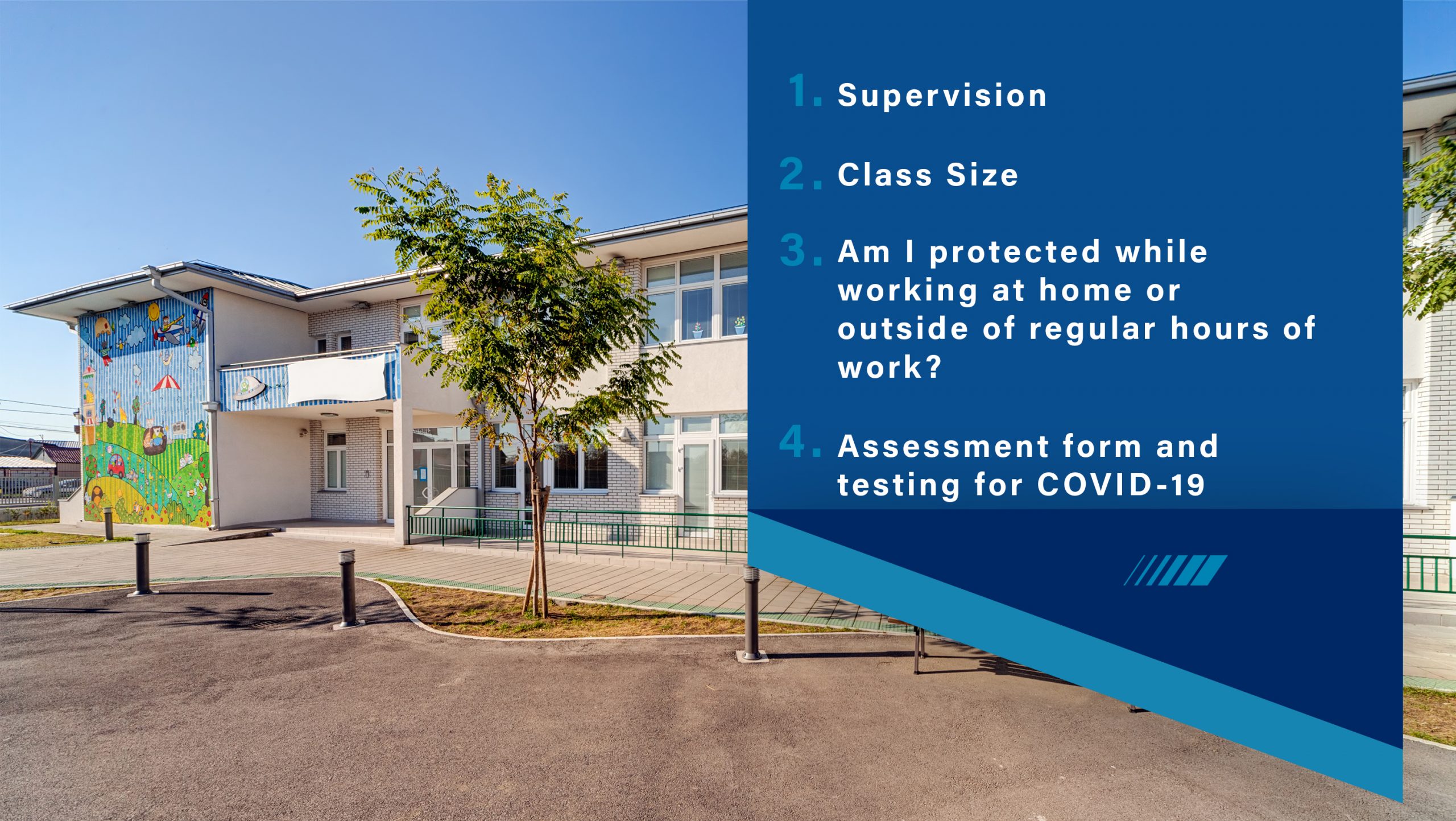The NBTF is currently receiving a high volume of calls regarding leaves related to COVID-19. We are in discussions with the employer on how these leaves should be handled by the school districts. We will keep you informed of developments as soon as possible.
In the meantime, we invite you to review our email sent on September 9, 2020, explaining the procedure to follow and to contact us with any questions or issues regarding these leaves at 1-888-679-7044.
// Supervision
Article 22 (A) 01 of the Collective Agreement states : “Non-teaching duties shall be kept to a minimum and evenly distributed among the staff.”
Elements to be considered
When are teachers expected to be at school in the morning?
Article 25(1)f of Regulations 97-150 of the Education Act requires teachers to be present in their classroom 20 minutes prior to the beginning of instruction time.
Can teachers be required to be at school earlier than 20 minutes before the commencement of instruction time?
Teachers may be required to be in school prior to the 20 minutes before the commencement of instruction time if they are assigned to do non-teaching duties (eg. supervision) as per Article 22 of the Collective Agreement. All non-teaching duties assigned to teachers, regardless of when they are completed, are to be considered when calculating the total amount of supervision time.
School administrators are responsible for determining the level of supervision required to maintain the health and safety of all students. The NBTF is aware that the situation surrounding COVID-19 resulted in an increase in supervision for the majority of teachers. This situation is exceptional and temporary. However, one of the key elements of Article 22 (A) 01 of the Collective Agreement is that supervision must be kept to a minimum. Requiring all teachers to arrive earlier than 20 minutes prior to the commencement of instruction time to supervise or to be responsible for students during all breaks and lunchtime does not meet this threshold.
Also, the Government has recently reached an agreement with CUPE so that Educational Assistants and School Intervention Workers can assist teachers with mornings and after-class duties.
Questions regarding non-teaching duties can be discussed with NBTF staff.
// Class Size
Class size numbers have remained the same since the 2009-2010 school year. Here are the maximum numbers of students for each grade level in accordance with Article 20 of the Collective Agreement:
| Grades | Maximum Number of Students per Class |
| K-2 | 21 |
| Grade 3 | 27 |
| Grades 4-12 | 29 |
| Grades | Combined Classes of Two or More Grades |
| K-3 | 16 |
| 3-5 | 23 |
| 5-12 | 24 |
Notes:
- Class size maximums are in effect the first day of school. At no time after the beginning of the school year shall teachers or the employer agree to go beyond the above class size numbers.
- The employer has the right to combine students of different grades in a class provided that the number of students in these classes respects the maximum numbers indicated in the Collective Agreement (see table above).
- The EECD’s Return to School Plan suggests the following maximum number of students per class:
| Grades | Maximum Number of Students per Class |
| K-2 | Reduced grouping size, as close to 15 students, wherever possible |
| 3-5 | Reduced grouping size, as close to 22 students, wherever possible |
| 6-8 | Regular class size |
| 9-12 | Attendance on a rotational basis (minimum every other day) except where schools can accommodate physical distancing of one metre. |
- These class sizes are not the regular class size under the Collective Agreement. The number of students has been reduced because of COVID19 and are reflected in the EECD return to school plan for the 2020-2021 school year.
We invite any teacher who has questions regarding class size to contact the NBTF by email at nbtf-fenb@nbtffenb.ca.
// Am I protected while working at home or outside of regular hours of work?
Members have contacted the NBTF with questions and concerns regarding incidents that could happen while working at home or while working at school outside the regular hours of work. Would they be covered by WorkSafeNB (WSNB) if they were in an accident in these situations? The NBTF has requested clarifications from WSNB and here is the information that we can provide:
To be compensable, the incident must have been the result of an accident arising out of and in the course of the worker’s employment. Therefore, while an accident occurring at home during work hours may be compensable, it is not always the case. For example, if the teacher was sitting at a desk in his/her home, got up from a chair to get a book for the class and twisted an ankle, that may be compensable. However, if the same teacher were to get up from the chair and proceed to the front door of the house to get mail out of the mailbox and twisted an ankle, that would probably not be compensable. One action is related to the course of employment while the other action is not, at least at first glance. The key is that every incident must be assessed on a case-by-case basis to make the determination if it is compensable or not. If a teacher has been injured and there is a question about the incident, they should file a claim and it will be assessed through the adjudication process.
Here is the access to the WSNB Policy, Conditions for Entitlement – Tests of Time, Place and Activity, that applies to the general circumstances.
This policy provides a number of examples and outlines the three main criteria (time, place and activity) that WSNB evaluates in the adjudication of claims.
// Self-Assessment and Referral Form for COVID-19
The Province launched a new self-assessment and referral form for COVID-19. Through this form, you can answer some basic questions, provide demographic information, and ask for a COVID-19 test. The referrals go directly to your chosen COVID-19 testing location. There are priority groups identified (such as school personnel) that can qualify for testing if they are asymptomatic:

Find the self-assessment and referral form by clicking here.
Note: This form does not work well in Chrome. Please open the link in Explorer or Safari to avoid any issues.








